What Is a Company Profile?
A company profile is your brand's professional introduction to your audience. It's meant to inform visitors and prospects on your products, services, and current positioning in the market. A well crafted company profile is a way to make yourself stand out from the competition and offer how you're unique.
Very few things in the world of business copywriting ignite such mixed feelings as the company profile.
In general, business owners love a company profile. They want to delve into every little detail of how their firm grew into the commercial powerhouse it is today – faithfully recounting every step from the childhood lemonade stand to the board meeting 15 minutes ago.
On the other hand, the average company profile is a snooze-fest for most customers and clients.
The reason is simple: Most of the time, the company profile is “me, me, me.”
It doesn’t address what matters to your most important audience: your prospects.
What to Include in Your Company Profile
The trickiest aspect of writing a profile is knowing what to say. What is it that visitors are actually looking for? What are they hoping to learn?
It's important to include info that falls under these three main umbrellas in order to make sure you're sharing enough valuable information:
Business Details
These are the basic facts of your company, like contact info and a brief overview of the business:
- Company name
- Location addresses
- Phone numbers
Company Details
This is where you can get a bit more detailed in who your company is and what it stands for:
- Mission statement and vision
- Established date
- Description of what you do (products and/or services)
- Brief overview of history, growth, and development
- Client portfolio
Industry Recognition
If you're looking to prove your worth, then don't be afraid to flash your feathers a bit. Share anything noteworthy that your company has accomplished or received:
- Certifications
- Awards
- Media/news recognition
- Testimonials
- Partnerships
How to Write a Company Profile
If you write a company profile with your value add in mind, you can turn the structure of the old-fashioned company profile on its head.
This will help hook readers with the facts most relevant to them – so they’ll feel more inclined to get all the way to the end.
Here’s how you can do it.
Start With What You Do for Others.
Here’s the crux: A company profile is just like other kinds of business writing. If you want it to get attention, lead with what’s in it for others when they do business with you.
Think back to your company’s one sentence branding statement. In other words, how do you finish the sentence: “We help [X] to [Y] ...?”
You rarely go wrong by making this the very first sentence of your company profile.
It cuts through the clutter and hooks those who might be your next ideal customer, partner, or employee – and, after all, that’s who you’re really writing to. Isn’t it?
Add Your Value Statement.
Now that the reader is acquainted with what you do, it’s time to delve into how you do it. When cost and features don’t quite differentiate one vendor from another, decision-makers look for values that resonate with them.
Here, you can include things like your vision for corporate responsibility or some community organizations you’ve worked with.
Just remember that this shouldn’t be an exhaustive list, just enough to pique curiosity and show you are thinking about the subject.
Put in Your Contact Information.
Contact information is essential for any company profile. Virtually all profiles either start online or end up there at some point in the future.
Contact details not only help people take action on your profile, but also contribute to your visibility in local SEO.
Naturally, this should include phone, URL, and email.
Fax looks increasingly stodgy, so leave it out unless it’s a recognized standard in your industry.
List Out Some of Your Top Clients.
No matter whether you’re in B2B or B2C, everyone wants to know that people “just like them” have had success with your product or service.
B2B enterprises have an advantage here, since they can easily choose the largest, wealthiest, or most prestigious company they’ve worked with. In B2C, exactly who your “top clients” are requires a little interpretation.
Really contemplate the profile, where it will be seen, and who its audience is. You can try thinking in the aggregate, as in:
- How many people have all your offerings helped?
- What is the big factor customers have in common?
- What feeling or role is the offering associated with?
- What percentage of customers say they are happy?
- What percentage of customers are repeat customers?
All these methods can give you a sense of scope even if you don’t have a big name endorsement.
Hit Them With Your Testimonials.
The right testimonial can add a sense of personality and even urgency to your company profile, letting it do double duty as a lead magnet that might drive people to interact with your brand.
In B2B, your best testimonials are probably associated with your biggest clients.
Remember to try to select a quote from either the most authoritative person (CEOs), the most well-known (author or other thought leader), or the one who most closely matches your ideal buyer.
In B2C, a customer’s formal title probably isn’t as important as what they have to say. Look for short, pithy quotes that align with your brand values and underscore your top benefits.
All in all, a company profile shouldn’t have more than three short testimonials. More than this and some venues might refuse to publish your profile as written, seeing it as too promotional.
Don’t Forget a Call to Action.
It’s a weird quirk of human nature any experienced marketer has seen time and time again: People usually won’t take the next step, even if they know exactly what it is, unless you ask them.
A CTA within a company profile should be evergreen and not refer to any specific offer.
Even something as simple as “Visit our website” or “Contact us for more details” can suffice here. Here's an example of a simple button CTA that you could use:
FAQs About Writing a Company Profile
Should a Profile Include the Company’s Story, Like Who Founded It and When?
If your company has been around the block, you might take the time to say a little bit about its founding principles – especially if it’s at least a century old.
You can usually fit this neatly into the section or paragraph where you talk about values. Recent founding can be worth mentioning if your company is disruptive, had a successful IPO, or obtained investor funding.
Should a Profile Have Information About Recent Product Launches or Other Fresh News?
In general, a profile should be designed to age gracefully so inaccurate or outdated information doesn’t percolate through the web and media channels.
As the previous question shows, though, there are some exceptions. A profile isn’t a press release, so newsworthy content isn’t needed – but anything that’s intended to be part of the company’s overall story could be woven in.
Should a Company Profile Use Paragraphs With Headers or Stick to Regular Text?
Take a cue from whatever platform you plan to post your profile on, but remember this: Most people aren’t inherently interested in a company’s story.
So, while headers will definitely make it easy to navigate the text, you might want to craft paragraphs short enough to not need them.
Where the Heck Will I Use a Company Profile, Anyway?
Although it’s not one of the biggest traffic draws, many people would say a company website isn’t really complete without a profile.
On your own site, of course, you’ll have more options when it comes to formatting – for example, you could present it in the form of a timeline.
In general, though, you should put together the text you want on your site, then mix and match various elements according to what you need to focus on for a given publication or platform.
The version on your Facebook might zoom in on your founding, the one you submit to Fortune or Forbes might talk more about recent funding or product launches, and so on.
Some places where you might need a profile include:
- Your own website
- Your LinkedIn Company Page
- Your Facebook community
- Industry publications
- Event and association websites
Company Profile Examples
Take a page out of the books of some successful companies. These examples have great company profiles that help them stand out from the crowd and prove their worth.
Zappos
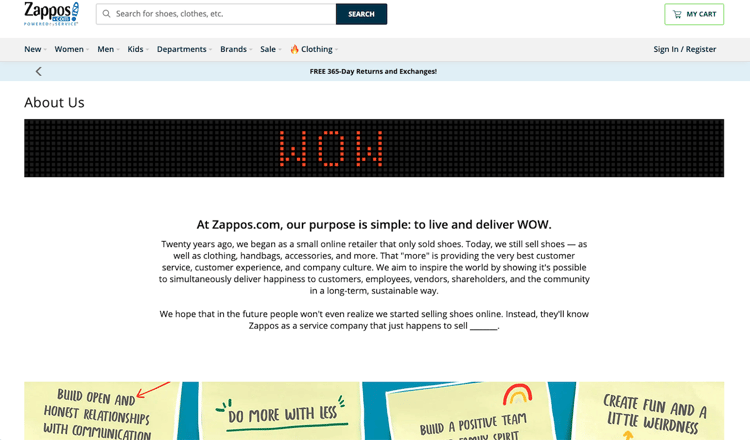
Zappos is well known for their customer service, and they highlight that in their profile. Their About Us page tells a story of service and growth, all centered around their customers.
For more insight, they've included a video highlighting their company culture and their 10 core values that guide their business.
Philips
Philips also leverages using multiple pages to tell their full story, but their main page uses incredible visual elements to tell visitors about the company's origins and beliefs.
It's not incredibly text heavy, hitting only on important facts and offering links to pages with more details.
Starbucks
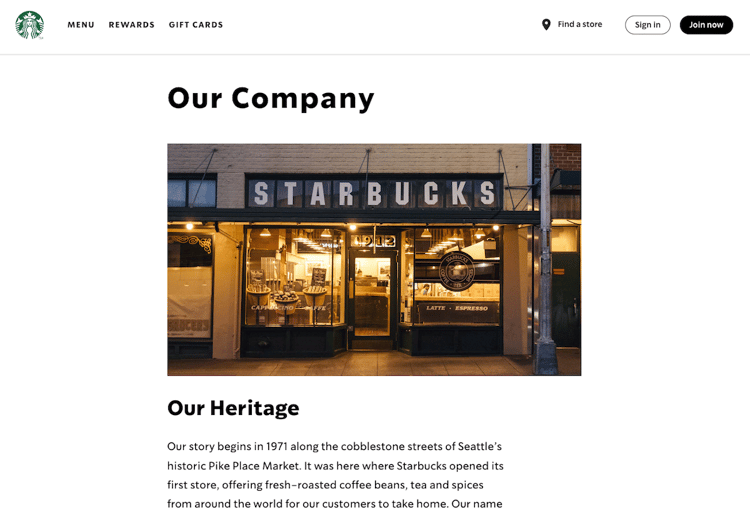
Starbucks offers a look into the operations, from their start in 1971 to their store numbers and brand portfolio. They leverage white space to reduce any noise when communicating their products, mission, and messaging.
Their language is incredibly genuine also, providing real personality to the coffee brand.
Venmo
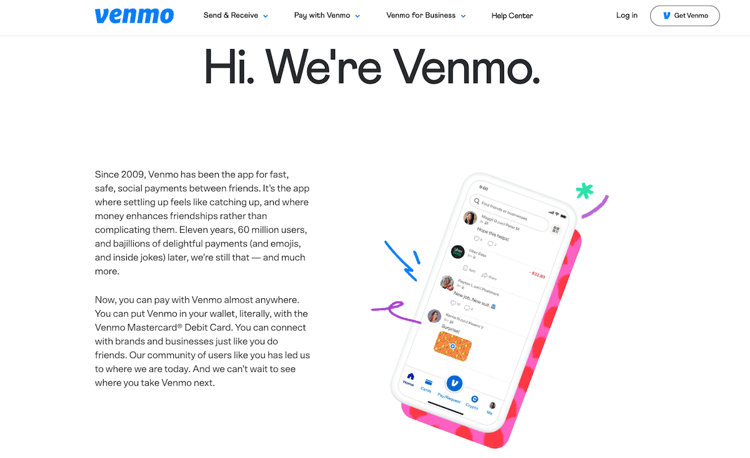 Venmo shares their company history before diving into how day-to-day users benefit from their app. In their company profile, they use a whimsical tone paired with eye-catching graphics to portray Venmo’s friendly approach to payments.
Venmo shares their company history before diving into how day-to-day users benefit from their app. In their company profile, they use a whimsical tone paired with eye-catching graphics to portray Venmo’s friendly approach to payments.
Throughout their company profile, Venmo uses simple CTA buttons to encourage users to get to know them a little bit better.
HubSpot
HubSpot does a great job of informing visitors in their company profile. With unique graphics and an easy-to-read layout, visitors can learn about the company's mission, milestones, and products.
Toward the end of the page, they highlight their growth and accomplishments in an effort to let you know that they get results.
Spotify
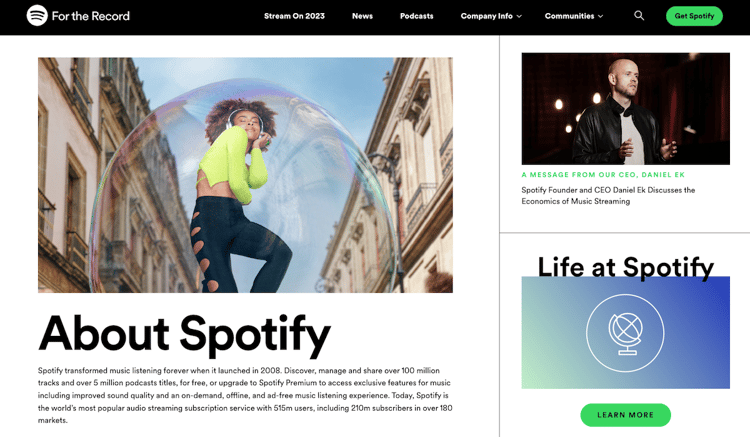
Spotify uses lots of block sections to state their mission and share a bit about their background. Here, they share some important stats and links to encourage listeners to view more information about their brand.
This page is easy to navigate so users can find exactly what they're looking for while getting to know the company in a way that feels comfortable.
Bloomberg

Bloomberg has a unique approach to their company profile. While they have well written copy and branching pages for more information, similar to the other examples above, this company makes its mark by offering video for practically every page it has.
They recognize the accessibility and power that comes with utilizing visual elements to engage their visitors, and it makes for a truly engrossing experience as you learn more about not only their business, but their culture as well.
Netflix
Netflix begins by sharing their value statement, connecting their audience with the mission behind their business. They also use an interactive timeline to share their history and promote engagement with website visitors.
A strength seen on the Netflix company profile is the familiar use of their video background that reminds viewers of the imagery displayed at the beginning of their movies and shows, increasing familiarity and trust with their brand.
Get Started With an Effective Company Profile
As you can see from these examples, a strong company profile is one of the first steps toward earning the trust and attention of new leads.
Your prospects want to know more about who they're doing business with. You don't just make a deal and shake hands with a stranger you know nothing about.
Follow these tips and your company profile can serve a useful function in your branding strategy, helping communicate what makes you special while drawing new customers in.




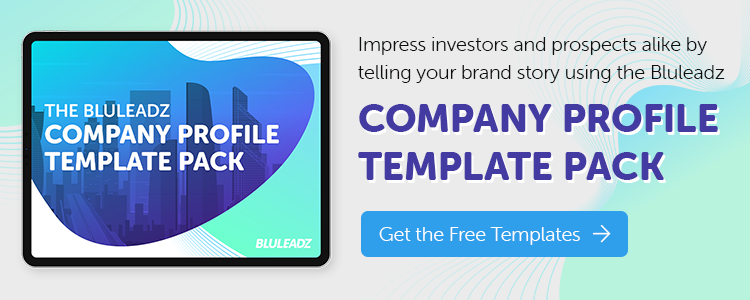
Jackie Jacobson
Jackie is a Copywriter at Bluleadz. She graduated from Elon University with a degree in Creative Writing and is currently living in Charlotte, NC. If you need her, you can find her exploring the city or relaxing with a good book.